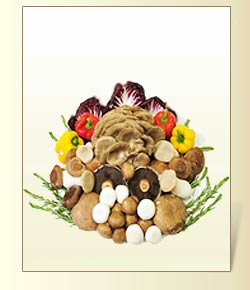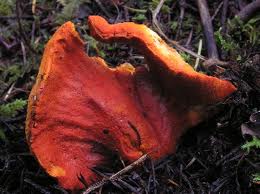The whole thing is called the lobster mushroom because of its red "shell" on the outside with white inside, much like cutting open a lobster, as shown to the left in my delicious dinner last August at the Humboldt Field Research Institute, Eagle Hill, Maine, where I taught a class on basidiomycetes. However, the red crust on the outside is the stromatic sterile tissue of the ascomycete (Hypomyces), and the white flesh on the inside is the flesh of a basidiomycete mushroom, presumably a Russula or Lactarius (more on this later). It's almost like mycological cannibalism! Not so coincidentally the title of my lecture at the Northeast Mycological Federation Foray at U-Mass in August is/was "Mycological Cannibalism: Fungi that eat other fungi." I'll tell you about some of the others briefly here.
There are a number of other fungi that get their nutrition directly from other fungi, parasitizing them. Most of the spectacular ones parasitize the fruiting body of the host, but there are likely many more (like Trichoderma) that just parasitize the vegetative mycelium. Some examples are Tremella species on Stereum or other corticioid fungi, Asterophora parasitica on blackening Russula species, Psathyrella epimyces on Coprinus comatus, Spinellus on Mycena haematopus, Squamanita species on a wide variety of basidiomycete fungal hosts, and many dozens of examples of various Hypomyces species on a wide variety of hosts. One other important fungal parasite is one I'm about to publish a paper on with Dan Czederpiltz and Hal Burdsall, showing that Entoloma abortivum is actually the parasite in the relationship with Armillaria species, causing the Armillaria fruiting body to abort. We will recommend that the common name be changed to the abortive Entoloma, and the misshapen carpophoroids be called aborted Armillaria's. After the paper is published, I'll make Entoloma abortivum a FOTM and tell you the whole story.
Tapenade is traditionally a caper-olive paste. Adding roasted vegetables not only makes it more attractive but also lighter and more delicious.
Preparation Time: 15 Minutes
Cooking Time: Not Available
Broiling Time: 20 minutes
Servings: About 2 cups (500 mL)
Ingredients:
- 1 Ontario Greenhouse Sweet Red Pepper, seeded and quartered
- 8 oz (250 g) Ontario Mushrooms, halved
- 2 tbsp (25 mL) olive oil
- 1 Ontario Onion (unpeeled), halved
- 2 cloves Ontario Garlic, minced
- 1/2 cup (125 mL) stuffed green olives
- 2 tbsp (25 mL) red wine vinegar
- 2 tbsp (25 mL) chopped fresh basil or parsley
- 1/4 tsp (1 mL) black pepper
- Pinch of cayenne pepper
- Whole wheat pita triangles or low-fat crackers
Preparation:
Toss red pepper pieces and mushrooms with 1 tbsp (15 mL) of the oil. Place red pepper, mushrooms and onion on baking sheet with onion and pepper cut side down. Broil on middle rack for about 20 minutes or until skins are blackened. Let cool for 5 minutes. Peel red pepper and onion, discarding skins. Cut red pepper and onion into chunks.
Place roasted vegetables, garlic, olives, remaining oil and vinegar in food processor; process until finely chopped but not puréed. Place in bowl; stir in basil, black pepper and cayenne pepper. Chill until ready to serve on pita triangles.




